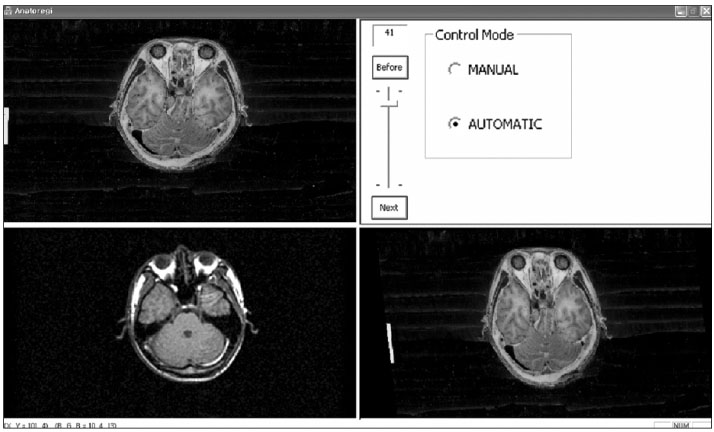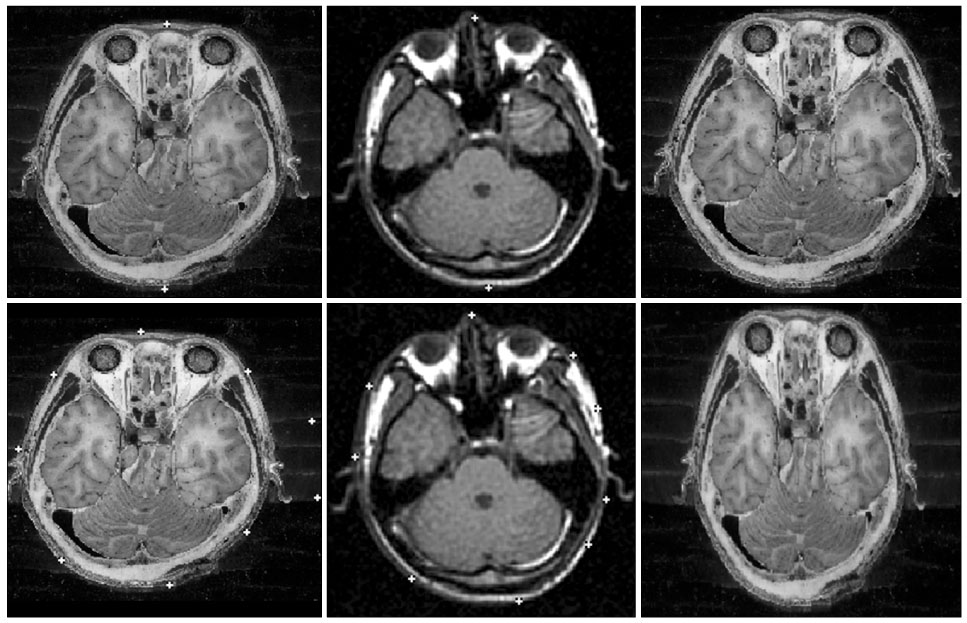J Korean Soc Med Inform.
2009 Jun;15(2):209-216. 10.4258/jksmi.2009.15.2.209.
Registration of Cadaver's Sectioned Images to Patient's Head MRIs
- Affiliations
-
- 1Department of Anatomy, Dongguk University College of Medicine, Korea.
- 2Department of Electrical Engineering and Computer Science, Seoul National University, Korea.
- 3Department of Anatomy, Ajou University School of Medicine, Korea. dissect@ajou.ac.kr
- 4Department of Computer Science, Hong-ik University, Korea.
- 5Department of Computer Science & Information Engineering, Inha University, Korea.
- KMID: 2211390
- DOI: http://doi.org/10.4258/jksmi.2009.15.2.209
Abstract
OBJECTIVE
Cadaver's sectioned images with high resolution and real color could be used as the source of realistic three-dimensional images. If the sectioned images are registered to a patient's MRIs, three-dimensional images with high resolution and real color that fit the patient, can be produced; the three-dimensional images enable realistic virtual surgery for the patient. The objective of this study was to verify the registration of a cadaver's sectioned images to a patient's head MRIs. METHODS: The sectioned images of the heads of cadaver were associated with segmented images selected at 3 mm intervals. The patient had his head MR scanned at 3 mm intervals; the MRIs were segmented. Software to register the cadaver's sectioned images to the patient's MRIs was developed. On this software, the corresponding dots were identified on both the sectioned images and the MRIs either manually or automatically using segmented images. RESULTS: The registered sectioned images corresponded to the patient's MRIs. Both manual and automatic registrations were satisfied. CONCLUSION: Further study is needed for registering sectioned images to actual patients.
MeSH Terms
Figure
Reference
-
1. Park JS, Chung MS, Hwang SB, Lee YS, Har DH, Park HS. Visible Korean Human: improved serially sectioned images of the entire body. IEEE Trans Med Imaging. 2005. 24:352–360.
Article2. Park JS, Chung MS, Hwang SB, Shin BS, Park HS. Visible Korean Human: its techniques and applications. Clin Anat. 2006. 19:216–224.
Article3. Park JS, Chung MS, Shin BS, Kwon KJ. Manufacture of the serially sectioned images of the whole body (Fifth report: methods for manufacture of the three dimensional images and virtual dissection software). Korean J Anat. 2004. 37:175–190.4. Li L, Liu YX, Song ZJ. Three-dimensional reconstruction of registered and fused Chinese Visible Human and patient MRI images. Clin Anat. 2006. 19:225–231.
Article5. Park JS, Chung MS, Hwang SB, Lee YS, Har DH. Technical report on semiautomatic segmentation using the Adobe Photoshop. J Digit Imaging. 2005. 18:333–343.
Article6. Spitzer VM, Ackerman MJ, Scherzinger AL, Whitlock DG. The Visible Human Male. A technical report. J Am Med Inform Assoc. 1996. 3:118–130.
Article7. Zhang SX, Heng PA, Liu ZJ. Chinese Visible Human Project. Clin Anat. 2006. 19:204–215.
Article8. Van De Graaff KM. Human anatomy. 1998. 5th ed. Boston: WCB McGraw-Hill;27761–762.9. Park JS, Shin DS, Chung MS, Hwang SB, Chung J. Technique of semiautomatic surface reconstruction of the Visible Korean Human data using commercial software. Clin Anat. 2007. 20:871–879.
Article
- Full Text Links
- Actions
-
Cited
- CITED
-
- Close
- Share
- Similar articles
-
- Manufacture of the Serially Sectioned Images of the Whole Body (Fourth Report: Methods for Selection and Treatment of the Cadaver and for Scanning of the MRIs and CTs)
- Manufacture of the Serially Sectioned Images of the Whole Body (First Report: Methods for Embedding and Serial Sectioning)
- Advanced Sectioned Images of a Cadaver Head with Voxel Size of 0.04 mm
- Identification of cranial nerve ganglia using sectioned images and three-dimensional models of a cadaver
- Segmentation of Cerebral Gyri in the Sectioned Images by Referring to Volume Model







